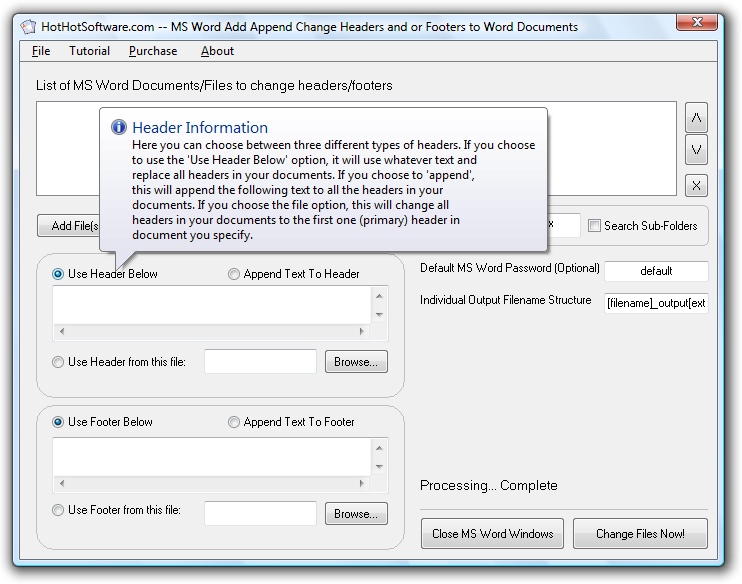

- #HOW DO YOU CLOSE THE HEADER AND FOOTER IN WORD HOW TO#
- #HOW DO YOU CLOSE THE HEADER AND FOOTER IN WORD PDF#
- #HOW DO YOU CLOSE THE HEADER AND FOOTER IN WORD ZIP FILE#
When you apply a heading level (such as Heading 3), an additional heading level should appear in the Gallery (such as Heading 4). You may need to click the More arrow on the bottom right of the Styles Gallery to view more styles and then click the style you want to use.Īll available heading styles do not appear initially in the Styles Gallery. Click the heading style you want in the Styles Gallery (such as Heading 1) in the Style group.
 Click in the paragraph (title or subheading) you want to designate or format as a heading. To create headings by applying heading styles: You can change theme options using the Design tab in the Ribbon. Heading styles are affected by your theme choices (overall theme, color theme, and font theme). A paragraph in Word is anything with a hard return after it (you have pressed Return or Enter). Heading styles are technically available as paragraph and character styles, but it's important to apply them as paragraph styles to entire paragraphs. There are 9 levels of headings available in Word. To create or designate headings, you will need to apply the built-in heading styles in order (Heading 1, Heading 2, Heading 3, and so) to paragraphs. Creating headings by applying Word heading styles
Click in the paragraph (title or subheading) you want to designate or format as a heading. To create headings by applying heading styles: You can change theme options using the Design tab in the Ribbon. Heading styles are affected by your theme choices (overall theme, color theme, and font theme). A paragraph in Word is anything with a hard return after it (you have pressed Return or Enter). Heading styles are technically available as paragraph and character styles, but it's important to apply them as paragraph styles to entire paragraphs. There are 9 levels of headings available in Word. To create or designate headings, you will need to apply the built-in heading styles in order (Heading 1, Heading 2, Heading 3, and so) to paragraphs. Creating headings by applying Word heading styles 
Note: Screenshots in this article are from Word 365 but are very similar in previous versions of Word.
Create a structured PDF (portable document format) file with heading tags. Rearrange a document using the Outline View. Navigate using the Navigation Pane (select Navigation Pane on the View tab in the Ribbon). In addition to creating structure, heading styles are also used to: They can also save you a lot of time formatting and reformatting documents. Heading styles are very important because they create structure in your documents and are readable by screen readers or assistive technology programs used by people with vision impairments. Recommended article: How to Hide Comments in Word (or Display Them)ĭo you want to learn more about Microsoft Word? Check out our virtual classroom or in-person classroom Word courses > Once you have applied heading styles, you'll be able to navigate to the headings using the Navigation Pane and create a table of contents. After you have applied styles, you can modify them and change the font, size, color, and other formatting attributes so the entire document will update. You can create headings in Microsoft Word documents by applying Word's built-in heading styles (such as Heading 1 or Heading 2). Import .* import .* import .DocPicture import .Apply and Customize Headings in Word Documentsīy Avantix Learning Team | Updated April 19, 2022Īpplies to: Microsoft ® Word ® 2010, 2013, 2016, 2019, 2021 or 365 (Windows)
Save the document to another file using Document.saveToFile() method. Add Field_Page field and Field_Num_Pages field to the footer paragraph using footerParagraph.appendField() method and set the format for them. Add a paragraph to footer using footer.addParagraph() method. Insert text as a header using headerParagraph.appendText() method and set the text format. Insert an image as a header using headerParagraph.appendPicture() method and set the position for the image. Add a paragraph to header using header.addParagraph() method. Using section.getHeadersFooters().getHeader() method to get header and section.getHeadersFooters().getFooter() method to get footer. Get the first section using Document.getSections().get() method. Create a Document instance and load a sample Word document using Document.loadFromFile() method. Spire.Doc supports to add text, images, lines and page numbers to the header or footer of a Word documents. Method 2: If you are not using maven, you can download the JAR file from this link, extract the zip file and then import the file under the lib folder into your project as a dependency. Enter fullscreen mode Exit fullscreen mode







 0 kommentar(er)
0 kommentar(er)
